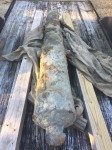![]() A Colonial-era cannon has been recovered from Cape Fear River at the Brunswick Town/Fort Anderson State Historic Site (BTFA) in North Carolina. It was pulled from the river during a dredging operation on December 21st. The cannon is 93 inches long with an 80-inch bore four inches in diameter. There are no visible markings to identify the type of cannon and a section of the muzzle is gone, perhaps damaged in an explosion caused by a casting flaw. For now all experts can say is that it was likely a six or nine-pounder manufactured before 1756.
A Colonial-era cannon has been recovered from Cape Fear River at the Brunswick Town/Fort Anderson State Historic Site (BTFA) in North Carolina. It was pulled from the river during a dredging operation on December 21st. The cannon is 93 inches long with an 80-inch bore four inches in diameter. There are no visible markings to identify the type of cannon and a section of the muzzle is gone, perhaps damaged in an explosion caused by a casting flaw. For now all experts can say is that it was likely a six or nine-pounder manufactured before 1756.
Brunswick was an important port town on the banks of the Cape Fear River in Colonial times. Founded in 1726, the town grew into a center for the trade in tar, pitch and turpentine, necessary materials for the construction and maintenance of the wooden ships of the era. Its commercial and naval significance were matched by Brunswick’s political prominence. Two royal governors in a row had their official residences in the town and the colonial assembly met in the courthouse. Royal taxes were also collected there. Brunswick challenged the collection of stamp taxes eight years before colonists disguised as Native Americans threw East India Company tea into Boston Harbor.
 The town began to fade in significance when the residence of the royal governor was moved to New Bern in 1770. By the time of the Revolutionary War, Brunswick’s population was depleted, which turned out to be a good thing when British troops burned the town in 1776. The town was never rebuilt. In the mid-19th century, the Orton Plantation took over the land, but what was left of Brunswick became strategically important again during the Civil War when Fort Anderson was built in 1861 as part of the Cape Fear defenses protecting Wilmington and running the Union blockade.
The town began to fade in significance when the residence of the royal governor was moved to New Bern in 1770. By the time of the Revolutionary War, Brunswick’s population was depleted, which turned out to be a good thing when British troops burned the town in 1776. The town was never rebuilt. In the mid-19th century, the Orton Plantation took over the land, but what was left of Brunswick became strategically important again during the Civil War when Fort Anderson was built in 1861 as part of the Cape Fear defenses protecting Wilmington and running the Union blockade.
The historic site focuses on both the Colonial and Civil War history. The discovery of the cannon has given the BTFA a unique opportunity to study and conserve a Colonial artifact at Brunswick where it was used 250 years or so ago.
The cannon currently sits, wrapped in burlap and under a light water spray to keep it wet, at Brunswick Town/Fort Anderson, until efforts can be made towards conservation.
“It was logical that it should stay here,” [Brunswick Town/Fort Anderson Site Manager Jim] McKee said. “But what is going to be so unique about this, is this is the first opportunity that an artifact like this is actually going to be conserved on site. Now that the gun is here … there’s no reason for it to ever leave again.”
The cannon is awaiting conservation efforts. McKee said the cannon will be visible to the public during that time. It’s the first of its kind at the site and could take several years before the restoration is complete.
Here’s an interview with Jim McKee perched next to the cannon discussing its discovery and conservation.
[youtube=https://youtu.be/yjGLsEC_SAA&w=430]